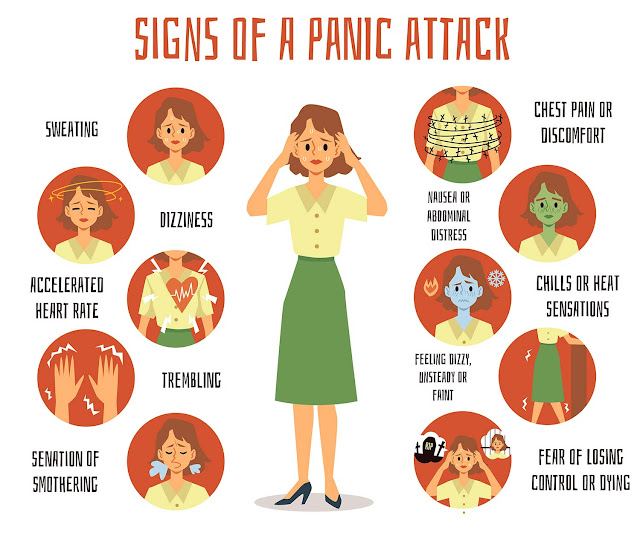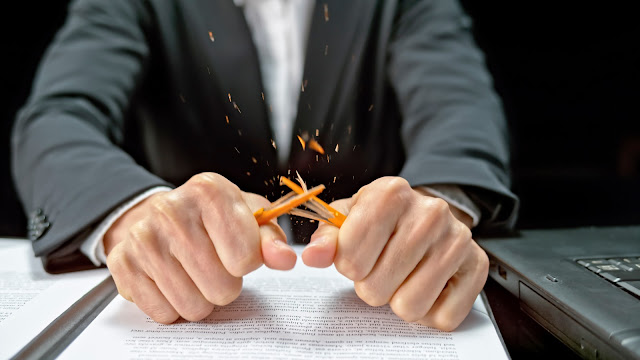Something feels terribly off all of a sudden. You suspect that you could be letting go of control. You experience physical symptoms that resemble serious medical conditions, and you occasionally experience a sense of impending death or catastrophe.
Over time, the sensation gets stronger. It becomes too much to handle. You experience an intense moment of absolute terror, as if this is your last time on earth, and then it vanishes mysteriously.
It's possible that the symptoms you experienced were as severe as a heart attack. However, it's more likely that what you experienced was an anxiety attack. Anxiety attacks are acute bursts of pure anguish that result in tangible physical symptoms and generate devastatingly intense anxiety.
 |
| image credit: simplypsychology.org |
An Introduction to Anxiety Attacks and Panic Attacks
Because anxiety attacks are not a psychiatric concept, different people may have slightly different definitions of them. However, anxiety attacks and panic attacks are frequently used interchangeably (or as a way of referring to lighter versions of panic attacks that are a bit less debilitating but still very troublesome).
A panic attack is a brief episode of extreme anxiety that lasts for only a few minutes, typically around ten. You frequently go through a variety of physical and mental symptoms during an anxiety attack, which can leave you feeling terribly scared and exhausted afterward. These consist of:
Other strange symptoms that are frequent during an anxiety attack and all add to the panic are common. Anxiety attacks often peak around 10 minutes in and then gradually subside over a few hours, leaving the victim exhausted, agitated, and occasionally wondering what went wrong.
Also read: How to Deal With Anxiety Attacks
Rarely are these panic episodes only apprehensive or anxious feelings. They include intense physical and mental activity. People who have never experienced a panic attack may not always be aware that they are experiencing one. Some people have their first anxiety attack in such a way that they need to call the hospital because they fear the worst.
What Triggers an Anxiety Attack?
Anxiety attacks are distinctive in that they can occur at times of extreme stress or terror or for no apparent reason at all. The first anxiety attack frequently occurs when a person is under a lot of stress in their life (although not always). Future panic attacks, however, could be brought on by nearly anything:
Once more, this is because anxiety attacks can seem and feel so irrational, therefore not everyone who experiences them is aware of or thinks they are experiencing an anxiety attack. Due to how challenging it is to feel as though one's anxiety attacks are actually happening, those who experience panic attacks too frequently may even begin to develop additional anxiety disorders, such health anxiety.
However, not everyone who experiences one anxiety attack will experience another. Some people only have anxiety attacks when they are extremely stressed out, exhausted, or when they are in a risky position. You might have a panic attack, for instance, if you nearly had a vehicle accident, but only because your anxiety was unbearably high at the time.
However, a lot of people who experience panic episodes do so again. Depending on the person.
What Do Anxiety Attacks Feel Like?
Because anxiety attacks are so physically intense, people frequently mistake them for serious illnesses, and in certain situations, they can even make people feel uneasy about their health. For many people, having an anxiety attack is similar to having one of the following diseases:
If an anxiety attack occurs just once, the person may learn to deal with it and their worries about a health issue may go away. Others may have anxiety attacks that are so intense that develop major health anxieties that necessitate hospitalization or multiple doctor appointments.
Noting that only a doctor can rule out more serious problems, there is no harm in consulting a doctor to get a medical opinion on the causes of your experiences and to get some peace of mind. But take note that it can be quite challenging for a doctor to persuade you that you are healthy if you experience anxiety episodes. The only way to get relief from anxiety attacks is frequently to treat them.
Alternative: Anxiety Attack Definition
As we noted before, the phrase "anxiety attack" refers to a very strong episode of anxiety rather than a medical condition. For the sake of simplicity, the majority of people, including some medical experts, refer to panic attacks as "anxiety attacks." When you say "panic," most people immediately picture someone fleeing from Godzilla. People typically grasp it better when you refer to it as "anxiety attacks."
However, not everyone uses the phrase "anxiety attack" in the same way because it is not a medical term. Some people refer to extreme symptoms of different anxiety disorders as "anxiety attacks" in order to describe their experience. For instance, people with obsessive-compulsive disorder may experience "anxiety attacks" when they come across a trigger that causes them to get deeply engrossed in their compulsions. When an exam is coming up at school, students may refer to their intense nervousness as a "anxiety attack," despite the fact that they are really just talking about being really apprehensive.
Also read: How to Manage Social Anxiety
Remember this when individuals talk about having an anxiety attack because the term could cause some misunderstanding. However, for the sake of this post, we'll focus on panic attacks because they are a very real, very prevalent anxiety problem that the majority of individuals mean when they claim to experience these attacks.
Why Do Anxiety Attacks Cause These Physical Symptoms?
The fact that anxiety attacks frequently result in physical symptoms that resemble those of more serious illnesses is one of the main reasons why they are such a terrifying experience. Many people have extreme health anxiety as a result of this since they don't think anxiety could possibly create such a physical reaction.
Hyperventilation is the most frequent physical response that anxiety may induce, and it can explain the majority of the anxiety symptoms.
What is hyperventilation?
Your body needs oxygen to survive, and when that oxygen is depleted in the bloodstream, it converts it to carbon dioxide, but your body also needs a healthy quantity of carbon dioxide in your circulatory system. Hyperventilation is the process of breathing either too quickly or improperly so that you are exhaling too much carbon dioxide and inhaling too much oxygen.
It's interesting to note that at this period, you can feel as if you're not breathing enough, and your natural inclination might be to take deeper breaths. However, by trying to inhale more oxygen in response to that sensation, you are really exacerbating your hyperventilation. For this reason, people who attempt to take deeper breaths frequently experience their symptoms getting worse, which adds to their anxiety.
You experience the signs of an anxiety attack when your blood doesn't contain enough carbon dioxide, including:
Observe how each of these sensations is the same as when you have acute anxiety; this is why the symptoms frequently feel so bodily and the condition frequently feels like a "attack." They reinforce one another to provide the impression that something is seriously wrong.
Overbreathing, a typical reaction to anxiety, is the most likely cause of hyperventilation. However, it's not the sole reason. Additionally, you might experience excessive breathing because:
Therefore, although the most frequent cause of hyperventilation is rapid breathing when under stress or anxiety, it is not the only one.
Anxiety-related hyperventilation is not harmful. All that needs to be done for your body to feel balanced again is wait for the anxiety episode to pass. However, anxiety symptoms do seem scary when they occur, which is why so many people feel a surge of fear and panic.
Also read: How Much Does a Nurse Practitioner Make?
Other Causes of Anxiety Attack Symptoms
Another factor contributing to the symptoms of an anxiety episode is hyperventilation. Your body may feel highly odd sensations as a result of stress and anxiety, which frequently vary from person to person. Anxiety and tension may make some people feel as though they are unable to lift their heads or that something is wrong with their brain.
Furthermore, anxiety often makes the brain hyper-aware of experiences that would otherwise be normal. Because of over-sensitization, your mind is so attuned to your body that it pays attention to very minute sensations that a person without worry would ordinarily dismiss.
Last but not least, anxiety attack symptoms itself can potentially be a trigger. Although the etiology is unknown, it is probably psychosomatic in some way (caused by your mind).
How to Control an Anxiety Attack
Once an anxiety attack has begun, it can be challenging to stop it, but there are methods for lessening its intensity. Try the following if you think you're experiencing or about to have an anxiety attack:
Once they begin, anxiety attacks are very difficult to stop, but by following the advice above, you can lessen their intensity. The less frightening and easier to manage your panic attacks are, the less severe they need to be.
Anxiety Attack Prevention
You'll need to take action to stop them once your anxiety episodes are more under control. Although an anxiety attack may only happen once, it is nevertheless a sign of a more serious anxiety disorder, and many patients discover that their episodes start to reoccur frequently.
Prevention is about three things:
A excellent place to start is always the doctor. To feel more at ease with your health, ensure that you've had a thorough physical. Try to avoid using panic attack drugs, though, as the majority have side effects including extreme exhaustion and others that make them unsuitable for everyday usage.
Start working out as well. Exercise is a proven stress reliever and one of the best strategies to reduce daily worry. Additionally, it's a beneficial approach to retrain your breathing. Running can help your body relearn how to breathe properly since it forces your body to breathe as efficiently as possible.










